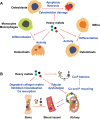Adverse Impact of Heavy Metals on Bone Cells and Bone Metabolism Dependently and Independently through Anemia
- PMID: 33042736
- PMCID: PMC7539179
- DOI: 10.1002/advs.202000383
Adverse Impact of Heavy Metals on Bone Cells and Bone Metabolism Dependently and Independently through Anemia
Abstract
Mounting evidence is revealing that heavy metals can incur disordered bone homeostasis, leading to the development of degenerative bone diseases, including osteoporosis, osteoarthritis, degenerative disk disease, and osteomalacia. Meanwhile, heavy metal-induced anemia has been found to be intertwined with degenerative bone diseases. However, the relationship and interplay among these adverse outcomes remain elusive. Thus, it is of importance to shed light on the modes of action (MOAs) and adverse outcome pathways (AOPs) responsible for degenerative bone diseases and anemia under exposure to heavy metals. In the current Review, the epidemiological and experimental findings are recapitulated to interrogate the contributions of heavy metals to degenerative bone disease development which may be attributable dependently and independently to anemia. A few likely mechanisms are postulated for anemia-independent degenerative bone diseases, including dysregulated osteogenesis and osteoblastogenesis, imbalanced bone formation and resorption, and disturbed homeostasis of essential trace elements. By contrast, remodeled bone microarchitecture, inhibited erythropoietin production, and disordered iron homeostasis are speculated to account for anemia-associated degenerative bone disorders upon heavy metal exposure. Together, this Review aims to elaborate available literature to fill in the knowledge gaps in understanding the detrimental effects of heavy metals on bone cells and bone homeostasis through different perspectives.
Keywords: adverse outcome pathways; anemia; degenerative bone diseases; heavy metals; mode of actions.
© 2020 The Authors. Published by Wiley‐VCH GmbH.
Conflict of interest statement
The authors declare no conflict of interest.
Figures






Similar articles
-
New insights into disruption of iron homeostasis by environmental pollutants.J Environ Sci (China). 2015 Aug 1;34:256-8. doi: 10.1016/j.jes.2015.06.001. Epub 2015 Jun 30. J Environ Sci (China). 2015. PMID: 26257368
-
Heavy metals accumulation affects bone microarchitecture in osteoporotic patients.Environ Toxicol. 2017 Apr;32(4):1333-1342. doi: 10.1002/tox.22327. Epub 2016 Jul 27. Environ Toxicol. 2017. PMID: 27464007
-
Implications of metal accumulation mechanisms to phytoremediation.Environ Sci Pollut Res Int. 2009 Mar;16(2):162-75. doi: 10.1007/s11356-008-0079-z. Epub 2008 Dec 6. Environ Sci Pollut Res Int. 2009. PMID: 19067014 Review.
-
Role of essential trace minerals on the absorption of heavy metals with special reference to lead.Indian J Clin Biochem. 2003 Jul;18(2):154-60. doi: 10.1007/BF02867382. Indian J Clin Biochem. 2003. PMID: 23105407 Free PMC article.
-
Heavy metals (Pb, Cd, As and MeHg) as risk factors for cognitive dysfunction: A general review of metal mixture mechanism in brain.Environ Toxicol Pharmacol. 2016 Dec;48:203-213. doi: 10.1016/j.etap.2016.09.016. Epub 2016 Sep 26. Environ Toxicol Pharmacol. 2016. PMID: 27816841 Review.
Cited by
-
Dominoes with interlocking consequences triggered by zinc: involvement of microelement-stimulated MSC-derived exosomes in senile osteogenesis and osteoclast dialogue.J Nanobiotechnology. 2023 Sep 23;21(1):346. doi: 10.1186/s12951-023-02085-w. J Nanobiotechnology. 2023. PMID: 37741978 Free PMC article.
-
Water Security and Nutrition: Current Knowledge and Research Opportunities.Adv Nutr. 2021 Dec 1;12(6):2525-2539. doi: 10.1093/advances/nmab075. Adv Nutr. 2021. PMID: 34265039 Free PMC article. Review.
-
Bioaccumulation and Haematological Alterations Induced by Varying Concentrations of Cadmium in Selected Organs of Golden Misri Chickens (Gallus gallus domesticus) in Khyber Pakhtunkhwa, Pakistan.ACS Omega. 2025 Aug 4;10(31):34608-34617. doi: 10.1021/acsomega.5c03393. eCollection 2025 Aug 12. ACS Omega. 2025. PMID: 40821532 Free PMC article.
-
From Cells to Environment: Exploring the Interplay between Factors Shaping Bone Health and Disease.Medicina (Kaunas). 2023 Aug 25;59(9):1546. doi: 10.3390/medicina59091546. Medicina (Kaunas). 2023. PMID: 37763665 Free PMC article. Review.
-
Iron, Zinc, Copper, Cadmium, Mercury, and Bone Tissue.Int J Environ Res Public Health. 2023 Jan 26;20(3):2197. doi: 10.3390/ijerph20032197. Int J Environ Res Public Health. 2023. PMID: 36767564 Free PMC article. Review.
References
-
- Rehman K., Fatima F., Waheed I., Akash M. S. H., J. Cell. Biochem. 2018, 119, 157. - PubMed
-
- Özcan M. M., Aljuhaimi F., Uslu N., Ghafoor K., Mohamed Ahmed I. A., Babiker E. E., Environ. Sci. Pollut. Res. Int. 2019, 26, 28210. - PubMed
-
- Morais S., Costa F., Pereira M., Heavy Met. Hum. Health 2012. 10.5772/29869. - DOI
LinkOut - more resources
Full Text Sources
